Mapping of Clay Montmorillonite Abundance in Agricultural Fields Using Unmixing Methods at Centimeter Scale Hyperspectral Images
Abstract
1. Introduction
- The Al–OH vibrational mode produces the 2200 nm absorption feature with a bandwidth around 100 nm whatever the clay type. Kaolinite also has a double absorption feature (2160 nm and 2206 nm), which is leftward asymmetric.
- OH-stretching bands combined with lattice vibrations produces absorption features at 2360 nm for both kaolinite and illite. This feature is shallow for illite and sharp for kaolinite. Kaolinite has also two absorption features at 2320 nm and 2380 nm.
- (1)
- How can spectral libraries or automatic EM detection benefit from unmixing method performances?
- (2)
- Which combined spectral preprocessing and unmixing algorithm is the most efficient strategy to estimate montmorillonite abundances in soil?
- (3)
- What is the impact of soil composition and other factors influencing montmorillonite abundance accuracy of ploughed fields at the centimeter scale?
2. Materials and Methods
2.1. Site Descriptions
- The knowledge of soil mineral composition:
- Soil swelling hazard maps from the BRGM [8] (Figure 1b) were used to roughly locate the previous XRD measurements. Their three classes (low/medium/high swelling classes) were selected using geotechnical analysis (MBT) and dominant lithology inside stratigraphic formations. The sites were chosen within the swelling class entity where the XRD measurements were sampled.
- An easy access to the selected sites given the field owner agreement.
- A low vegetation cover (less than 20%) observed on agricultural fields (the experiment has been carried out after wheat harvest, on freshly ploughed fields) (Figure 1c–e).
- “Le Buisson” locality in Coinces municipality, hereafter named Coinces (WGS 84, 48.00901°N, 1.734826°E). This site lies on a stratigraphic formation of Quaternary loam and loess, clayey and carbonated. The nearest XRD measurements indicate a composition of 11% kaolinite, 7% illite and 2% smectite, presenting a low swelling risk (Figure 1c).
- “Les Laps” locality in Gémigny municipality, hereafter named Gémigny (WGS 84, 47.95422°N, 1.689848°E). This site lies on a stratigraphic formation lower Pliocene sand and clay with dominant sand and clayey sand with metric clay layers. The nearest XRD measurement indicates 2.9% kaolinite, 5% illite and 43.5% smectite, presenting a high swelling risk (Figure 1d).
- “La Malandière” locality in Mareau-aux-près municipality, hereafter named “Mareau” (WGS 84, 47.83964°N, 1.758915°E). This site lies on a stratigraphic formation of recent Holocene Loire alluvium, mainly siliceous with local imbrications of loam and clay deposits. The nearest XRD measurements indicate 14.6% kaolinite, 6.5% illite and 0% smectite, presenting a low swelling risk (Figure 1e).
2.2. Hyperspectral Data Acquisitions
- Normalized difference vegetation index (NDVI) to detect green vegetation [60]:
- Chlorophyll absorption index (CAI) to detect dry vegetation [61]:
2.3. Field and Laboratory Measurements
2.4. General Methodology
2.4.1. Endmember Selection
2.4.2. Spectral Preprocessings
2.4.3. Unmixing Methods
2.4.4. Evaluation Criteria
2.4.5. Validation Methodology
3. Results
3.1. Endmember Detection and Comparison
3.2. Performance Analysis of Spectral Preprocessing Coupled with Unmixing Methods for Montmorillonite Abundance Estimation
3.3. Analysis of Montmorillonite Abundance Maps
3.3.1. At the Subzone Scale
- Gémigny-SUB14, characterized by a weak spatial variability of the roughness index (median and standard deviation of 0.51 cm and 0.68 cm (Figure 11c) and by a solar elevation angle of 44°.
- Coinces-SUB2, characterized by a large spatial variability of the roughness index (median and standard deviation of 83% and 0.51 cm and 0.68 cm (Figure 12c), and a solar elevation angle of 35.6°.
3.3.2. At the Image Scale
- On the Gémigny map, the estimated abundance values of clays increased inside wheel tracks located in SUB1, SUB2, SUB3, SUB7, SUB8 and SUB9 (Figure 14c). They contained more estimated montmorillonite than the other subzones (from around 4% to 5%).
- On the Coinces map (Figure 15c), the montmorillonite estimation was higher in left subzones (SUB1, SUB2, SUB6, SUB7, SUB11, SUB12) than in the right ones (SUB5 and SUB15). This trend was not present in any validation data but may have been due to the presence of clouds during the acquisitions. In the wet subzone (SUB10), the majority of pixels was wrongly classified as “dry vegetation”, and montmorillonite was estimated at around 40% in bare soils’ pixels.
- On the Mareau map, the montmorillonite estimation was around 20% in the wet subzone (SUB15), whereas the montmorillonite estimation in other pixels was around 15% (Figure 16c).
3.4. Estimation Performances of Other Mineral Abundance
4. Discussion
4.1. Endmembers Selection for Unmixing
4.2. Limitations of Preprocessings and Unmixing Methods for Montmorillonite Abundance Estimation
4.3. Impact of Soil Mineralogical Composition
4.4. Other Factors Influencing Montmorillonite Abundance Mapping
- The obtained performances degraded compared to those obtained over in-lab mixtures as these samples were dried, sieved and crushed to a powder with a flattened surface,
- The centimeter scale of spectroscopic acquisitions tended to exacerbate directional effects, both geometric (no local slope correction has been applied to retrieve surface reflectance) and optical (no anisotropic correction has been applied assuming only Lambertian materials), and so the spectral variability was increased, which could not be accounted by unmixing methods.
- The better the spatial resolution is, the wider the spatial variability is; thus, at a centimeter scale, the variability was very high compared to the reflectance at a meter scale where the soil heterogeneities were more smoothed.
- The presence of residual dry and wet vegetation and of shadows contributed to increasing the number of surface types seen by a pixel and then reducing the quality of the unmixing performances; an improved masking can be targeted in the future.
- The roughness of the ploughed fields induced surface multiple scatterings and variations of illuminations (direct and diffuse downwelling irradiance), which were taken into account in our unmixing models; [36] and, more recently, [88] have proposed a physical approach to take into account these effects. In particular, [88] proposed an extension of MLM to this end. Unfortunately, these approaches have never been tested at a centimeter scale also including intimate mixtures.
- The higher variability of mineral granulometry (10–35% for Gémigny, 10–31% for Mareau and 6–31% for Coinces accounting for textural clay and coarse sand, cf. Figure 4) impacted volume multiple scatterings and induced higher spectral variations, oppositely to the more homogeneous granulometry found for the laboratory mixtures, having either only clay minerals or clay minerals combined with calcite or quartz [12].
- The important contribution of other minerals than clay ones, mainly quartz for Gémigny and Coinces (abundance more than 58%), and quartz, potassium feldspars and plagioclases for Mareau (global abundance more than 50%).
- The presence of quartz in soils, such as noted by [11,21,92], that highlighted the difficulties to retrieve minerals and quantify their abundance when a mixture contains quartz, and also by [12] that confirmed this point in the laboratory where montmorillonite abundance estimation in the presence of quartz was very poor (RMSE more than 50%) whatever the unmixing method and the preprocessing.
- The atmospheric conditions, such as for Coinces, for which the experiment was performed under partially cloudy conditions with varying illumination, while in the laboratory, these conditions were controlled and stable in time.
- The soil water content led to an increase in montmorillonite abundance that could be explained by the decrease of global reflectance level due to the soil moisture content increase and the potential overestimation of the darkest EM (i.e., montmorillonite). However, in our case, the water content was low enough (<18%) to not mask the clay absorption band with soil moisture content, which happens for an SMC of 30% [39].
5. Conclusions
Author Contributions
Funding
Data Availability Statement
Acknowledgments
Conflicts of Interest
References
- Ministère de la Transition éCologique ET Solidaire, C. Général AU Développement Durable Retrait-Gonflement Des Sols Argileux: Plus de 4 Millions de Maisons Potentiellement Très Exposées. Available online: https://www.notre-environnement.gouv.fr/themes/risques/les-mouvements-de-terrain-et-les-erosions-cotieres-ressources/article/retrait-gonflement-des-sols-argileux-plus-de-4-millions-de-maisons (accessed on 17 August 2024).
- Crilly, M.S.; Driscoll, R.M.C. The Behaviour of Lightly Loaded Piles in Swelling Ground and Implications for Their Design. Proc. Inst. Civ. Eng.-Geotech. Eng. 2000, 143, 3–16. [Google Scholar] [CrossRef]
- Nelson, J.; Miller, D.J. Expansive Soils: Problems and Practice in Foundation and Pavement Engineering; John Wiley & Sons: Hoboken, NJ, USA, 1997; ISBN 978-0-471-18114-9. [Google Scholar]
- Li, J.; Zou, J.; Bayetto, P.; Barker, N. Shrink-Swell Index Database for Melbourne. Aust. Geomech. J. 2016, 51, 17. [Google Scholar]
- Kahle, M.; Kleber, M.; Jahn, R. Review of XRD-Based Quantitative Analyses of Clay Minerals in Soils: The Suitability of Mineral Intensity Factors. Geoderma 2002, 109, 191–205. [Google Scholar] [CrossRef]
- Zhou, X.; Liu, D.; Bu, H.; Deng, L.; Liu, H.; Yuan, P.; Du, P.; Song, H. XRD-Based Quantitative Analysis of Clay Minerals Using Reference Intensity Ratios, Mineral Intensity Factors, Rietveld, and Full Pattern Summation Methods: A Critical Review. Solid Earth Sci. 2018, 3, 16–29. [Google Scholar] [CrossRef]
- Dufréchou, G.; Grandjean, G.; Bourguignon, A. Geometrical Analysis of Laboratory Soil Spectra in the Short-Wave Infrared Domain: Clay Composition and Estimation of the Swelling Potential. Geoderma 2015, 243–244, 92–107. [Google Scholar] [CrossRef]
- Chassagneux, D.; Stieltjes, L.; Mouroux, P. Cartographie de l’aléa Retrait Gonflement Des Sols (Sécheresse/Pluie) Dans La Région de Manosque (Alpes de Haute-Provence). Echelle Communale et Départementale. Approche Méthodologique; BRGM: Orléans, France, 1995.
- Goetz, A.F.H. Three Decades of Hyperspectral Remote Sensing of the Earth: A Personal View. Remote Sens. Environ. 2009, 113 (Suppl. S1), S5–S16. [Google Scholar] [CrossRef]
- van der Meer, F.D.; van der Werff, H.M.A.; van Ruitenbeek, F.J.A.; Hecker, C.A.; Bakker, W.H.; Noomen, M.F.; van der Meijde, M.; Carranza, E.J.M.; Smeth, J.B.d.; Woldai, T. Multi- and Hyperspectral Geologic Remote Sensing: A Review. Int. J. Appl. Earth Obs. Geoinf. 2012, 14, 112–128. [Google Scholar] [CrossRef]
- Yitagesu, F.A.; van der Meer, F.; van der Werff, H.; Hecker, C. Spectral Characteristics of Clay Minerals in the 2.5–14 Μm Wavelength Region. Appl. Clay Sci. 2011, 53, 581–591. [Google Scholar] [CrossRef]
- Ducasse, E.; Adeline, K.; Briottet, X.; Hohmann, A.; Bourguignon, A.; Grandjean, G. Montmorillonite Estimation in Clay–Quartz–Calcite Samples from Laboratory SWIR Imaging Spectroscopy: A Comparative Study of Spectral Preprocessings and Unmixing Methods. Remote Sens. 2020, 12, 1723. [Google Scholar] [CrossRef]
- Galán, E. Chapter 14 Genesis of Clay Minerals. In Developments in Clay Science; Elsevier: Amsterdam, The Netherlands, 2006; Volume 1, pp. 1129–1162. ISBN 978-0-08-044183-2. [Google Scholar]
- van der Meer, F.D.; van der Werff, H.M.A.; van Ruitenbeek, F.J.A. Potential of ESA’s Sentinel-2 for Geological Applications. Remote Sens. Environ. 2014, 148, 124–133. [Google Scholar] [CrossRef]
- Bourguignon, A.; Delpont, G.; Chevrel, S.; Chabrillat, S. Detection and Mapping of Shrink–Swell Clays in SW France, Using ASTER Imagery. Geol. Soc. Lond. Spec. Publ. 2007, 283, 117–124. [Google Scholar] [CrossRef]
- Amer, R.; Kusky, T.; El Mezayen, A. Remote Sensing Detection of Gold Related Alteration Zones in Um Rus Area, Central Eastern Desert of Egypt. Adv. Space Res. 2012, 49, 121–134. [Google Scholar] [CrossRef]
- Ben-Dor, E.; Chabrillat, S.; Demattê, J.A.M.; Taylor, G.R.; Hill, J.; Whiting, M.L.; Sommer, S. Using Imaging Spectroscopy to Study Soil Properties. Remote Sens. Environ. 2009, 113 (Suppl. S1), S38–S55. [Google Scholar] [CrossRef]
- Grandjean, G.; Briottet, X.; Adeline, K.; Bourguignon, A.; Hohmann, A. Clay Minerals Mapping from Imaging Spectroscopy. In Earth Observation and Geospatial Analyses [Working Title]; IntechOpen: London, UK, 2019. [Google Scholar]
- Bhattacharya, S.; Majumdar, T.J.; Rajawat, A.S.; Panigrahi, M.K.; Das, P.R. Utilization of Hyperion Data over Dongargarh, India, for Mapping Altered/Weathered and Clay Minerals along with Field Spectral Measurements. Int. J. Remote Sens. 2012, 33, 5438–5450. [Google Scholar] [CrossRef]
- Bedini, E.; Chen, J. Application of PRISMA Satellite Hyperspectral Imagery to Mineral Alteration Mapping at Cuprite, Nevada, USA. J. Hyperspectral Remote Sens. 2020, 10, 87. [Google Scholar] [CrossRef]
- Kruse, F.A.; Boardman, J.W.; Huntington, J.F. Comparison of Airborne Hyperspectral Data and Eo-1 Hyperion for Mineral Mapping. IEEE Trans. Geosci. Remote Sens. 2003, 41, 1388–1400. [Google Scholar] [CrossRef]
- Chabrillat, S.; Goetz, A.F.H.; Krosley, L.; Olsen, H.W. Use of Hyperspectral Images in the Identification and Mapping of Expansive Clay Soils and the Role of Spatial Resolution. Remote Sens. Environ. 2002, 82, 431–445. [Google Scholar] [CrossRef]
- Priya, S.; Ghosh, R. Soil Clay Minerals Abundance Mapping Using AVIRIS-NG Data. Adv. Space Res. 2024, 73, 1360–1367. [Google Scholar] [CrossRef]
- Hohmann, A.; Bourguignon, A.; Grandjean, G. Cartographie Des Argiles Gonflantes En Milieux Tempérés à Partir de Données Hyperspectrales Aéroportées Couplées à Des Données in Situ et Laboratoire. In Proceedings of the 3Ème Colloque Scientifique du Groupe Hyperspectral de la Sfpt, Porquerolles, France, 14–16 May 2014. [Google Scholar]
- Garfagnoli, F.; Ciampalini, A.; Moretti, S.; Chiarantini, L.; Vettori, S. Quantitative Mapping of Clay Minerals Using Airborne Imaging Spectroscopy: New Data on Mugello (Italy) from SIM-GA Prototypal Sensor. Eur. J. Remote Sens. 2013, 46, 1–17. [Google Scholar] [CrossRef]
- Barton, I.F.; Gabriel, M.J.; Lyons-Baral, J.; Barton, M.D.; Duplessis, L.; Roberts, C. Extending Geometallurgy to the Mine Scale with Hyperspectral Imaging: A Pilot Study Using Drone- and Ground-Based Scanning. Min. Metall. Explor. 2021, 38, 799–818. [Google Scholar] [CrossRef]
- Kurz, T.H.; Buckley, S.J. A Review of Hyperpsectral Imaging in Close Range Applications. Int. Arch. Photogramm. Remote Sens. Spat. Inf. Sci. 2016, XLI-B5, 865–870. [Google Scholar] [CrossRef]
- Kirsch, M.; Lorenz, S.; Zimmermann, R.; Tusa, L.; Möckel, R.; Hödl, P.; Booysen, R.; Khodadadzadeh, M.; Gloaguen, R. Integration of Terrestrial and Drone-Borne Hyperspectral and Photogrammetric Sensing Methods for Exploration Mapping and Mining Monitoring. Remote Sens. 2018, 10, 1366. [Google Scholar] [CrossRef]
- Song, Q.; Gao, X.; Song, Y.; Li, Q.; Chen, Z.; Li, R.; Zhang, H.; Cai, S. Estimation and Mapping of Soil Texture Content Based on Unmanned Aerial Vehicle Hyperspectral Imaging. Sci. Rep. 2023, 13, 14097. [Google Scholar] [CrossRef] [PubMed]
- Murphy, R.J.; Schneider, S.; Monteiro, S.T. Mapping Layers of Clay in a Vertical Geological Surface Using Hyperspectral Imagery: Variability in Parameters of SWIR Absorption Features under Different Conditions of Illumination. Remote Sens. 2014, 6, 9104–9129. [Google Scholar] [CrossRef]
- Rodger, A.; Cudahy, T. Vegetation Corrected Continuum Depths at 2.20 Μm: An Approach for Hyperspectral Sensors. Remote Sens. Environ. 2009, 113, 2243–2257. [Google Scholar] [CrossRef]
- Haest, M.; Cudahy, T.; Rodger, A.; Laukamp, C.; Martens, E.; Caccetta, M. Unmixing the Effects of Vegetation in Airborne Hyperspectral Mineral Maps over the Rocklea Dome Iron-Rich Palaeochannel System (Western Australia). Remote Sens. Environ. 2013, 129, 17–31. [Google Scholar] [CrossRef]
- Ouerghemmi, W.; Gomez, C.; Naceur, S.; Lagacherie, P. Semi-Blind Source Separation for the Estimation of the Clay Content over Semi-Vegetated Areas Using VNIR/SWIR Hyperspectral Airborne Data. Remote Sens. Environ. 2016, 181, 251–263. [Google Scholar] [CrossRef]
- Bioucas-Dias, J.M.; Plaza, A.; Dobigeon, N.; Parente, M.; Du, Q.; Gader, P.; Chanussot, J. Hyperspectral Unmixing Overview: Geometrical, Statistical, and Sparse Regression-Based Approaches. IEEE J. Sel. Top. Appl. Earth Obs. Remote Sens. 2012, 5, 354–379. [Google Scholar] [CrossRef]
- Dobigeon, N.; Altmann, Y.; Brun, N.; Moussaoui, S. Linear and Nonlinear Unmixing in Hyperspectral Imaging. In Resolving Spectral Mixtures-with Application from Ultrafast Spectroscopy to Super-Resolution Imaging; Elsevier: Amsterdam, The Netherlands, 2016; Volume 45. [Google Scholar]
- Meganem, I.; Deliot, P.; Briottet, X.; Deville, Y.; Hosseini, S. Linear–Quadratic Mixing Model for Reflectances in Urban Environments. IEEE Trans. Geosci. Remote Sens. 2014, 52, 544–558. [Google Scholar] [CrossRef]
- Carmina, E. Impact Des Mélanges de Minéraux à Macro-éChelle Sur la Réflectance Spectrale de Surfaces Naturelles: ÉTude Empirique à Partir de Scénarios de Terrain. Ph.D. Thesis, University of Nantes, Nantes, France, 2012. [Google Scholar]
- Wu, C.-Y.; Jacobson, A.R.; Laba, M.; Baveye, P.C. Accounting for Surface Roughness Effects in the Near-Infrared Reflectance Sensing of Soils. Geoderma 2009, 152, 171–180. [Google Scholar] [CrossRef]
- Kariuki, P.C.; Woldai, T.; Meer, F.V.D. Effectiveness of Spectroscopy in Identification of Swelling Indicator Clay Minerals. Int. J. Remote Sens. 2004, 25, 455–469. [Google Scholar] [CrossRef]
- Weidong, L.; Baret, F.; Xingfa, G.; Qingxi, T.; Lanfen, Z.; Bing, Z. Relating Soil Surface Moisture to Reflectance. Remote Sens. Environ. 2002, 81, 238–246. [Google Scholar] [CrossRef]
- Lesaignoux, A.; Fabre, S.; Briottet, X.; Olioso, A.; Belin, E.; Cedex, T. Influence of Surface Soil Moisture on Spectral Reflectance of Bare Soil in the 0.4–15 μm Domain. In Proceedings of the 6th EARSeL SIG IS Workshop, Tel Aviv, Israel, 16–19 March 2009; p. 6. [Google Scholar]
- Castaldi, F.; Palombo, A.; Pascucci, S.; Pignatti, S.; Santini, F.; Casa, R. Reducing the Influence of Soil Moisture on the Estimation of Clay from Hyperspectral Data: A Case Study Using Simulated PRISMA Data. Remote Sens. 2015, 7, 15561–15582. [Google Scholar] [CrossRef]
- Hapke, B. Bidirectional Reflectance Spectroscopy: 1. Theory. J. Geophys. Res. 1981, 86, 3039–3054. [Google Scholar] [CrossRef]
- Shkuratov, Y.; Starukhina, L.; Hoffmann, H.; Arnold, G. A Model of Spectral Albedo of Particulate Surfaces: Implications for Optical Properties of the Moon. Icarus 1999, 137, 235–246. [Google Scholar] [CrossRef]
- Heylen, R.; Gader, P. Nonlinear Spectral Unmixing with a Linear Mixture of Intimate Mixtures Model. IEEE Geosci. Remote Sens. Lett. 2014, 11, 1195–1199. [Google Scholar] [CrossRef]
- Robertson, K.M.; Milliken, R.E.; Li, S. Estimating Mineral Abundances of Clay and Gypsum Mixtures Using Radiative Transfer Models Applied to Visible-near Infrared Reflectance Spectra. Icarus 2016, 277, 171–186. [Google Scholar] [CrossRef]
- Clark, R.N.; Swayze, G.A.; Livo, K.E.; Kokaly, R.F.; Sutley, S.J.; Dalton, J.B.; McDougal, R.R.; Gent, C.A. Imaging Spectroscopy: Earth and Planetary Remote Sensing with the USGS Tetracorder and Expert Systems. J. Geophys. Res. 2003, 108, 5131. [Google Scholar] [CrossRef]
- Carvalho, A.O.J.; Guimarães, R.F. Employment of the Multiple Endmember Spectral Mixture Analysis (MESMA) Method in Mineral Analysis; JPL Publication: Pasadena, CA, USA, 2001; pp. 73–80. [Google Scholar]
- Bouchut, J.; Giot, D. Cartographie de L’aléa Retrait-Gonflement Des Argiles Dans Le Département du Loiret; BRGM: Orléans, France, 2004.
- Dufréchou, G.; Hohmann, A.; Bourguignon, A.; Grandjean, G. Targeting and Mapping Expansive Soils (Loiret, France): Geometrical Analysis of Laboratory Soil Spectra in the Short-Wave Infrared Domain (1100–2500 Nm). Bull. De La Société Géologique De Fr. 2016, 187, 169–181. [Google Scholar] [CrossRef]
- Plyer, A.; Colin-Koeniguer, E.; Weissgerber, F. A New Coregistration Algorithm for Recent Applications on Urban SAR Images. IEEE Geosci. Remote Sens. Lett. 2015, 12, 2198–2202. [Google Scholar] [CrossRef]
- Brigot, G.; Colin-Koeniguer, E.; Plyer, A.; Janez, F. Adaptation and Evaluation of an Optical Flow Method Applied to Coregistration of Forest Remote Sensing Images. IEEE J. Sel. Top. Appl. Earth Obs. Remote Sens. 2016, 9, 2923–2939. [Google Scholar] [CrossRef]
- Smith, G.M.; Milton, E.J. The Use of the Empirical Line Method to Calibrate Remotely Sensed Data to Reflectance. Int. J. Remote Sens. 1999, 20, 2653–2662. [Google Scholar] [CrossRef]
- Karpouzli, E.; Malthus, T. The Empirical Line Method for the Atmospheric Correction of IKONOS Imagery. Int. J. Remote Sens. 2003, 24, 1143–1150. [Google Scholar] [CrossRef]
- Green, A.A.; Berman, M.; Switzer, P.; Maurice; Craig, D. A Transformation for Ordering Multispectral Data in Terms of Image Quality with Implications for Noise Removal. IEEE Trans. Geosci. Remote Sens. 1988, 26, 65–74. [Google Scholar] [CrossRef]
- Rogge, D.M.; Rivard, B.; Zhang, J.; Sanchez, A.; Harris, J.; Feng, J. Integration of Spatial–Spectral Information for the Improved Extraction of Endmembers. Remote Sens. Environ. 2007, 110, 287–303. [Google Scholar] [CrossRef]
- Bedini, E.; Meer, F.v.d.; Ruitenbeek, F.v. Use of HyMap Imaging Spectrometer Data to Map Mineralogy in the Rodalquilar Caldera, Southeast Spain. Int. J. Remote Sens. 2009, 30, 327–348. [Google Scholar] [CrossRef]
- Nagao, M.; Matsuyama, T.; Ikeda, Y. Region Extraction and Shape Analysis in Aerial Photographs. Comput. Graph. Image Process. 1979, 10, 195–223. [Google Scholar] [CrossRef]
- Adeline, K.R.M.; Chen, M.; Briottet, X.; Pang, S.K.; Paparoditis, N. Shadow Detection in Very High Spatial Resolution Aerial Images: A Comparative Study. ISPRS J. Photogramm. Remote Sens. 2013, 80, 21–38. [Google Scholar] [CrossRef]
- Rouse, J., Jr.; Haas, R.H.; Schell, J.A.; Deering, D.W. Monitoring Vegetation Systems in the Great Plains with ERTS. NASA Spec. Publ. 1974, 351, 309. [Google Scholar]
- Guerschman, J.P.; Hill, M.J.; Renzullo, L.J.; Barrett, D.J.; Marks, A.S.; Botha, E.J. Estimating Fractional Cover of Photosynthetic Vegetation, Non-Photosynthetic Vegetation and Bare Soil in the Australian Tropical Savanna Region Upscaling the EO-1 Hyperion and MODIS Sensors. Remote Sens. Environ. 2009, 113, 928–945. [Google Scholar] [CrossRef]
- Rupnik, E.; Daakir, M.; Pierrot Deseilligny, M. MicMac—A Free, Open-Source Solution for Photogrammetry. Open Geospat. Data Softw. Stand. 2017, 2, 14. [Google Scholar] [CrossRef]
- Brown, G. Crystal Structures of Clay Minerals and Their X-ray Identification; The Mineralogical Society of Great Britain and Ireland: Hampton, UK, 1982; ISBN 978-0-903056-08-3. [Google Scholar]
- Bish, D.L.; Post, J.E. Quantitative Mineralogical Analysis Using the Rietveld Full-Pattern Fitting Method. Am. Mineral. 1993, 78, 932–940. [Google Scholar]
- Kokaly, R.F.; Clark, R.N.; Swayze, G.A.; Livo, K.E.; Hoefen, T.M.; Pearson, N.C.; Wise, R.A.; Benzel, W.M.; Lowers, H.A.; Driscoll, R.L.; et al. USGS Spectral Library Version 7; Data Series; U.S. Geological Survey: Reston, VA, USA, 2017; p. 68.
- Miao, L.; Qi, H. Endmember Extraction From Highly Mixed Data Using Minimum Volume Constrained Nonnegative Matrix Factorization. IEEE Trans. Geosci. Remote Sens. 2007, 45, 765–777. [Google Scholar] [CrossRef]
- Bioucas-Dias, J. A Variable Splitting Augmented Lagrangian Approach to Linear Spectral Unmixing. In Proceedings of the 2009 First Workshop on Hyperspectral Image and Signal Processing: Evolution in Remote Sensing, Grenoble, France, 26–28 August 2009; pp. 1–4. [Google Scholar] [CrossRef]
- Nascimento, J.M.P.; Dias, J.M.B. Vertex Component Analysis: A Fast Algorithm to Unmix Hyperspectral Data. IEEE Trans. Geosci. Remote Sens. 2005, 43, 898–910. [Google Scholar] [CrossRef]
- Heinz, D.C.; Chang, C.-I. Fully Constrained Least Squares Linear Spectral Mixture Analysis Method for Material Quantification in Hyperspectral Imagery. IEEE Trans. Geosci. Remote Sens. 2001, 39, 529–545. [Google Scholar] [CrossRef]
- Roberts, D.A.; Gardner, M.; Church, R.; Ustin, S.; Scheer, G.; Green, R.O. Mapping Chaparral in the Santa Monica Mountains Using Multiple Endmember Spectral Mixture Models. Remote Sens. Environ. 1998, 65, 267–279. [Google Scholar] [CrossRef]
- Heylen, R.; Parente, M.; Gader, P. A Review of Nonlinear Hyperspectral Unmixing Methods. IEEE J. Sel. Top. Appl. Earth Obs. Remote Sens. 2014, 7, 1844–1868. [Google Scholar] [CrossRef]
- Heylen, R.; Scheunders, P. A Multilinear Mixing Model for Nonlinear Spectral Unmixing. IEEE Trans. Geosci. Remote Sens. 2016, 54, 240–251. [Google Scholar] [CrossRef]
- Kruse, F.A.; Lefkoff, A.B.; Boardman, J.W.; Heidebrecht, K.B.; Shapiro, A.T.; Barloon, P.J.; Goetz, A.F.H. The Spectral Image Processing System (SIPS)—Interactive Visualization and Analysis of Imaging Spectrometer Data. Remote Sens. Environ. 1993, 44, 145–163. [Google Scholar] [CrossRef]
- Revel, C.; Deville, Y.; Achard, V.; Briottet, X. Inertia-Constrained Pixel-by-Pixel Nonnegative Matrix Factorisation: A Hyperspectral Unmixing Method Dealing with Intra-Class Variability. arXiv 2017, arXiv:1702.07630. [Google Scholar]
- Rommel, D.; Grumpe, A.; Felder, M.P.; Wöhler, C.; Mall, U.; Kronz, A. Automatic Endmember Selection and Nonlinear Spectral Unmixing of Lunar Analog Minerals. Icarus 2017, 284, 126–149. [Google Scholar] [CrossRef]
- Crósta, A.P.; De Souza Filho, C.R.; Azevedo, F.; Brodie, C. Targeting Key Alteration Minerals in Epithermal Deposits in Patagonia, Argentina, Using ASTER Imagery and Principal Component Analysis. Int. J. Remote Sens. 2003, 24, 4233–4240. [Google Scholar] [CrossRef]
- Ben-Dor, E. Characterization of Soil Properties Using Reflectance Spectroscopy. In Hyperspectral Remote Sensing of Vegetation; CRC Press: Boca Raton, FL, USA, 2011; pp. 513–558. ISBN 978-1-4398-4537-0. [Google Scholar]
- Koirala, B.; Rasti, B.; Bnoulkacem, Z.; Ribeiro, A.d.L.; Madriz, Y.; Herrmann, E.; Gestels, A.; De Kerf, T.; Lorenz, S.; Fuchs, M.; et al. A Multisensor Hyperspectral Benchmark Dataset For Unmixing of Intimate Mixtures. IEEE Sens. J. 2023, 24, 4694–4710. [Google Scholar] [CrossRef]
- Fasnacht, L.; Vogt, M.-L.; Renard, P.; Brunner, P. A 2D Hyperspectral Library of Mineral Reflectance, from 900 to 2500 Nm. Sci. Data 2019, 6, 268. [Google Scholar] [CrossRef]
- Milliken, R.E.; Hiroi, T.; Scholes, D.; Slavney, S.; Arvidson, R. The NASA Reflectance Experiment LABoratory (RELAB) Facility: An Online Spectral Database for Planetary Exploration. In Proceedings of the Astromaterials Data Management in the Era of Sample-Return Missions Community Workshop, Virtual, 8–10 November 2021; Volume 2654. [Google Scholar]
- Safanelli, J.L.; Hengl, T.; Parente, L.; Minarik, R.; Bloom, D.E.; Todd-Brown, K.; Gholizadeh, A.; Mendes, W.D.S.; Sanderman, J. Open Soil Spectral Library (OSSL): Building Reproducible Soil Calibration Models through Open Development and Community Engagement. BioRxiv 2023, preprint. [Google Scholar] [CrossRef]
- Rinnan, Å.; Berg, F.v.d.; Engelsen, S.B. Review of the Most Common Pre-Processing Techniques for near-Infrared Spectra. TrAC Trends Anal. Chem. 2009, 28, 1201–1222. [Google Scholar] [CrossRef]
- Esquerre, C.; Gowen, A.A.; Burger, J.; Downey, G.; O’Donnell, C.P. Suppressing Sample Morphology Effects in near Infrared Spectral Imaging Using Chemometric Data Pre-Treatments. Chemom. Intell. Lab. Syst. 2012, 117, 129–137. [Google Scholar] [CrossRef]
- Viscarra Rossel, R.A.; McGlynn, R.N.; McBratney, A.B. Determining the Composition of Mineral-Organic Mixes Using UV–Vis–NIR Diffuse Reflectance Spectroscopy. Geoderma 2006, 137, 70–82. [Google Scholar] [CrossRef]
- Li, M.; Zhu, F.; Guo, A.J.; Chen, J. A Graph Regularized Multilinear Mixing Model for Nonlinear Hyperspectral Unmixing. Remote Sens. 2019, 11, 2188. [Google Scholar] [CrossRef]
- Fang, T.; Zhu, F.; Chen, J. Nonlinear Hyperspectral Unmixing Based on Multilinear Mixing Model Using Convolutional Autoencoders. arXiv 2023, arXiv:2303.08156. [Google Scholar]
- Li, M.; Yang, B.; Wang, B. A Coarse-to-Fine Scheme for Unsupervised Nonlinear Hyperspectral Unmixing Based on an Extended Multilinear Mixing Model. IEEE Trans. Geosci. Remote Sens. 2023, 61, 5521415. [Google Scholar] [CrossRef]
- Zhang, G.; Scheunders, P.; Cerra, D.; Muller, R. Shadow-Aware Nonlinear Spectral Unmixing for Hyperspectral Imagery. IEEE J. Sel. Top. Appl. Earth Obs. Remote Sens. 2022, 15, 5514–5533. [Google Scholar] [CrossRef]
- Jin, M.; Ding, X.; Han, H.; Pang, J.; Wang, Y. An Improved Method Combining Fisher Transformation and Multiple Endmember Spectral Mixture Analysis for Lunar Mineral Abundance Quantification Using Spectral Data. Icarus 2022, 380, 115008. [Google Scholar] [CrossRef]
- Mulder, V.L.; Plötze, M.; de Bruin, S.; Schaepman, M.E.; Mavris, C.; Kokaly, R.F.; Egli, M. Quantifying Mineral Abundances of Complex Mixtures by Coupling Spectral Deconvolution of SWIR Spectra (2.1–2.4 Μm) and Regression Tree Analysis. Geoderma 2013, 207–208, 279–290. [Google Scholar] [CrossRef]
- Mathieu, M.; Roy, R.; Launeau, P.; Cathelineau, M.; Quirt, D. Alteration Mapping on Drill Cores Using a HySpex SWIR-320m Hyperspectral Camera: Application to the Exploration of an Unconformity-Related Uranium Deposit (Saskatchewan, Canada). J. Geochem. Explor. 2017, 172, 71–88. [Google Scholar] [CrossRef]
- Jackisch, R.; Madriz, Y.; Zimmermann, R.; Pirttijärvi, M.; Saartenoja, A.; Heincke, B.H.; Salmirinne, H.; Kujasalo, J.-P.; Andreani, L.; Gloaguen, R. Drone-Borne Hyperspectral and Magnetic Data Integration: Otanmäki Fe-Ti-V Deposit in Finland. Remote Sens. 2019, 11, 2084. [Google Scholar] [CrossRef]
- Feng, J.; Rogge, D.; Rivard, B. Comparison of Lithological Mapping Results from Airborne Hyperspectral VNIR-SWIR, LWIR and Combined Data. Int. J. Appl. Earth Obs. Geoinf. 2017, 64, 340–353. [Google Scholar] [CrossRef]
- Notesco, G.; Ogen, Y.; Ben-Dor, E. Mineral Classification of Makhtesh Ramon in Israel Using Hyperspectral Longwave Infrared (LWIR) Remote-Sensing Data. Remote Sens. 2015, 7, 12282–12296. [Google Scholar] [CrossRef]
- Sawut, M.; Ghulam, A.; Tiyip, T.; Zhang, Y.; Ding, J.; Zhang, F.; Maimaitiyiming, M. Estimating Soil Sand Content Using Thermal Infrared Spectra in Arid Lands. Int. J. Appl. Earth Obs. Geoinf. 2014, 33, 203–210. [Google Scholar] [CrossRef]
- Bioucas-Dias, J.M.; Figueiredo, M.A.T. Alternating Direction Algorithms for Constrained Sparse Regression: Application to Hyperspectral Unmixing. arXiv 2010, arXiv:1002.4527. [Google Scholar]
- Iordache, M.-D.; Plaza, A.; Bioucas-Dias, J. On the Use of Spectral Libraries to Perform Sparse Unmixing of Hyperspectral Data; IEEE: New York, NY, USA, 2010; pp. 1–4. [Google Scholar]
- Whiting, M.L.; Li, L.; Ustin, S.L. Predicting Water Content Using Gaussian Model on Soil Spectra. Remote Sens. Environ. 2004, 89, 535–552. [Google Scholar] [CrossRef]
- Ou, D.; Tan, K.; Li, J.; Wu, Z.; Zhao, L.; Ding, J.; Wang, X.; Zou, B. Prediction of Soil Organic Matter by Kubelka-Munk Based Airborne Hyperspectral Moisture Removal Model. Int. J. Appl. Earth Obs. Geoinf. 2023, 124, 103493. [Google Scholar] [CrossRef]
- Bablet, A.; Vu, P.V.H.; Jacquemoud, S.; Viallefont-Robinet, F.; Fabre, S.; Briottet, X.; Sadeghi, M.; Whiting, M.L.; Baret, F.; Tian, J. MARMIT: A Multilayer Radiative Transfer Model of Soil Reflectance to Estimate Surface Soil Moisture Content in the Solar Domain (400–2500 Nm). Remote Sens. Environ. 2018, 217, 1–17. [Google Scholar] [CrossRef]
- Dupiau, A.; Jacquemoud, S.; Briottet, X.; Fabre, S.; Viallefont-Robinet, F.; Philpot, W.; Di Biagio, C.; Hébert, M.; Formenti, P. MARMIT-2: An Improved Version of the MARMIT Model to Predict Soil Reflectance as a Function of Surface Water Content in the Solar Domain. Remote Sens. Environ. 2022, 272, 112951. [Google Scholar] [CrossRef]
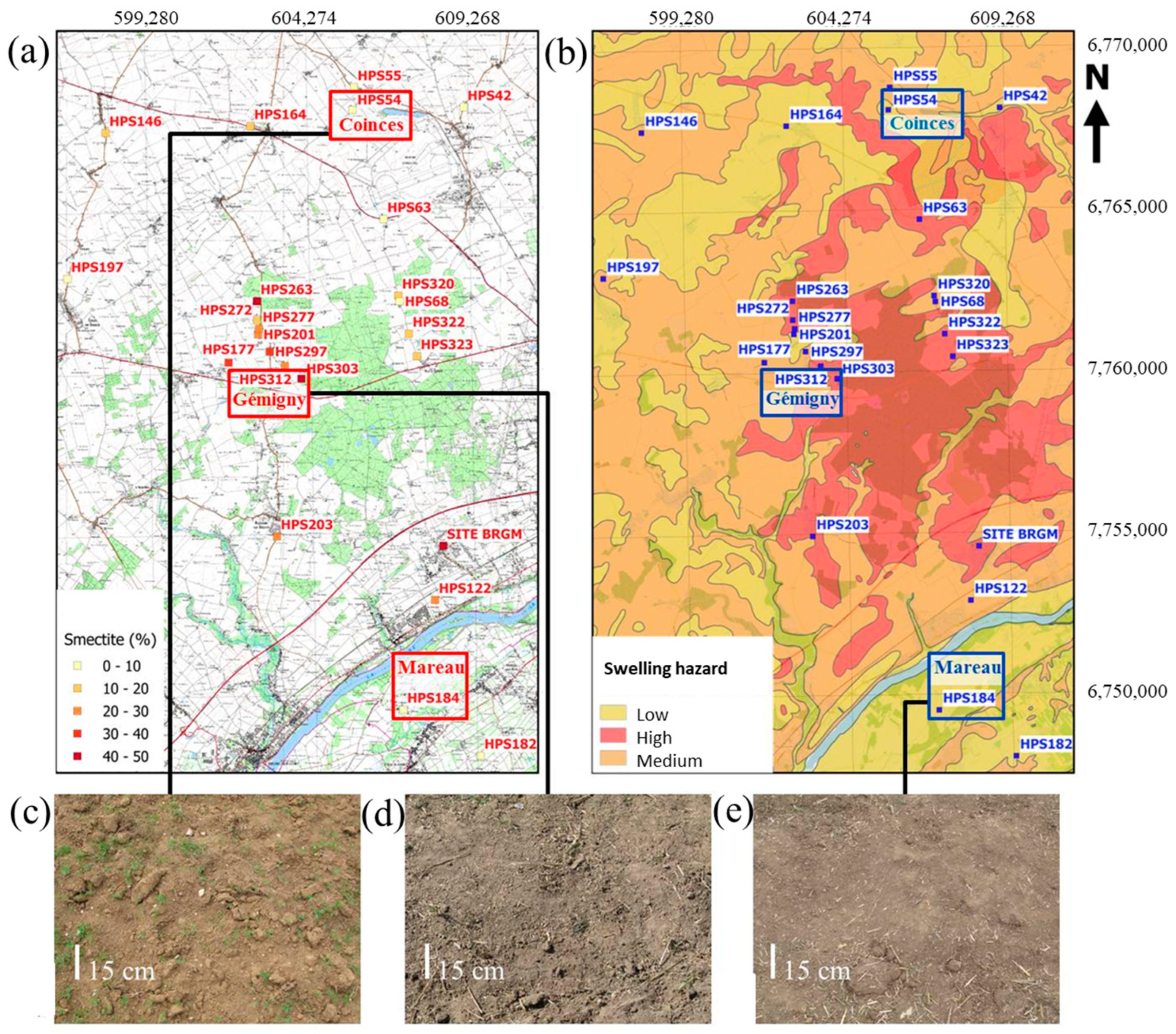
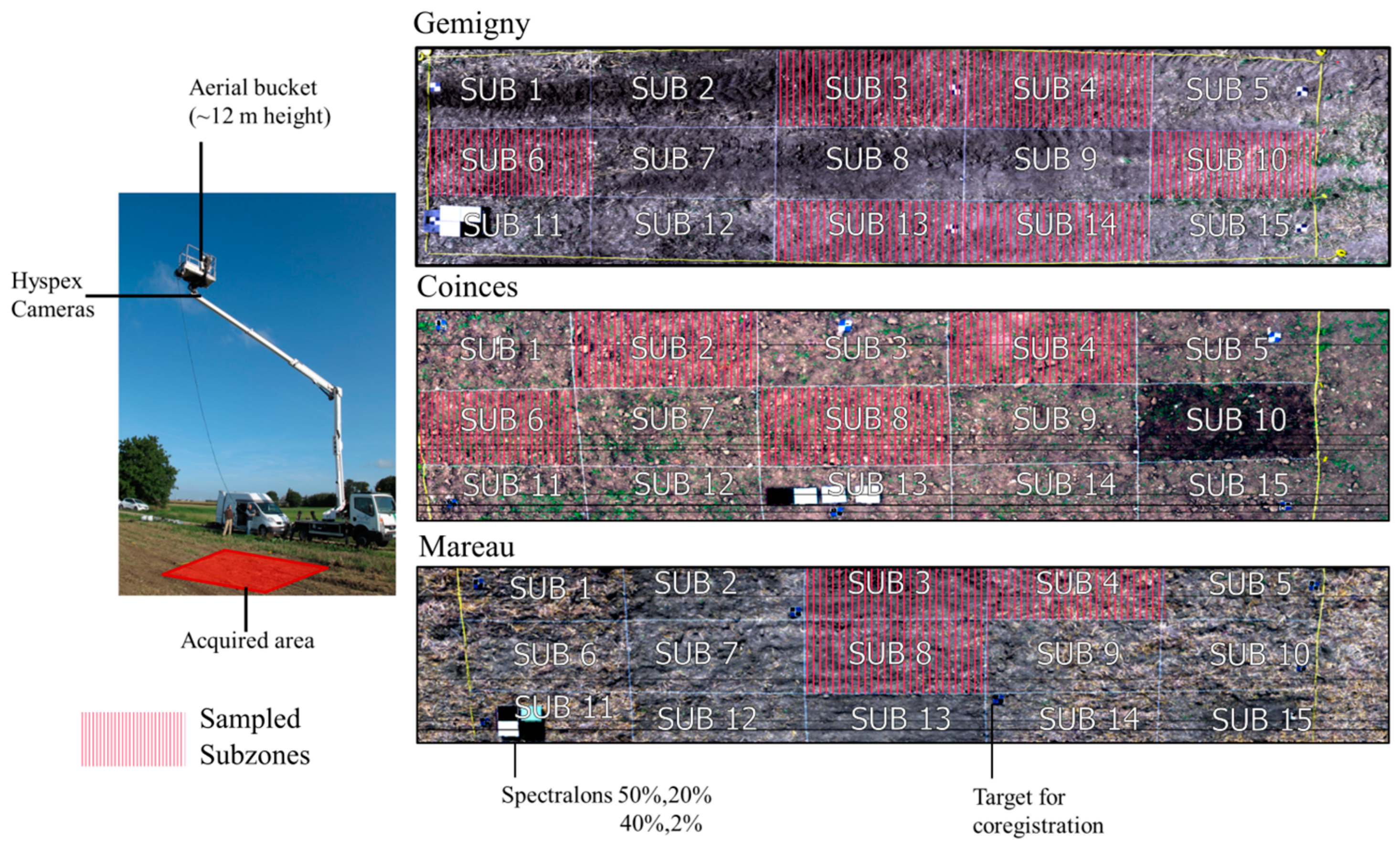
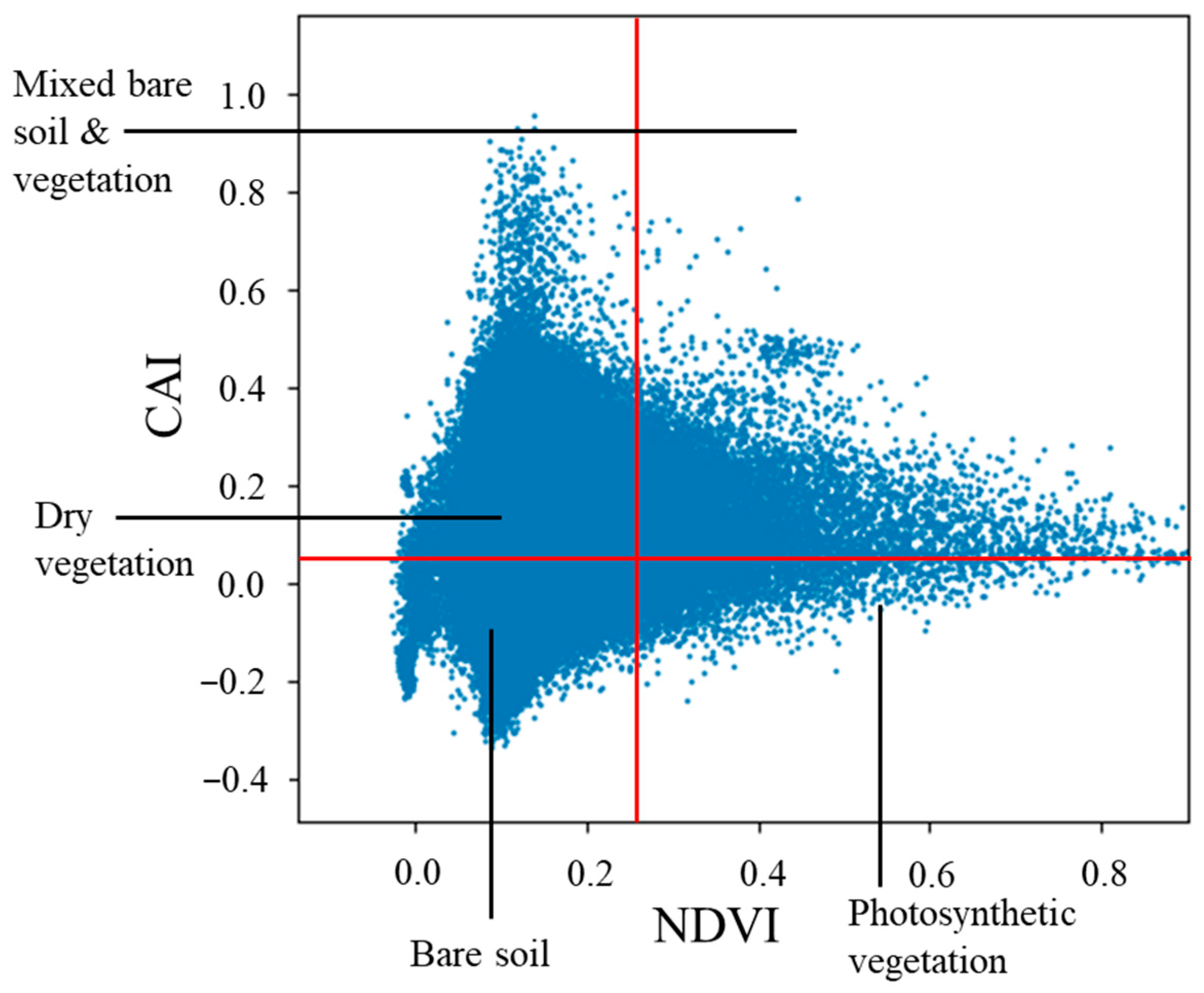


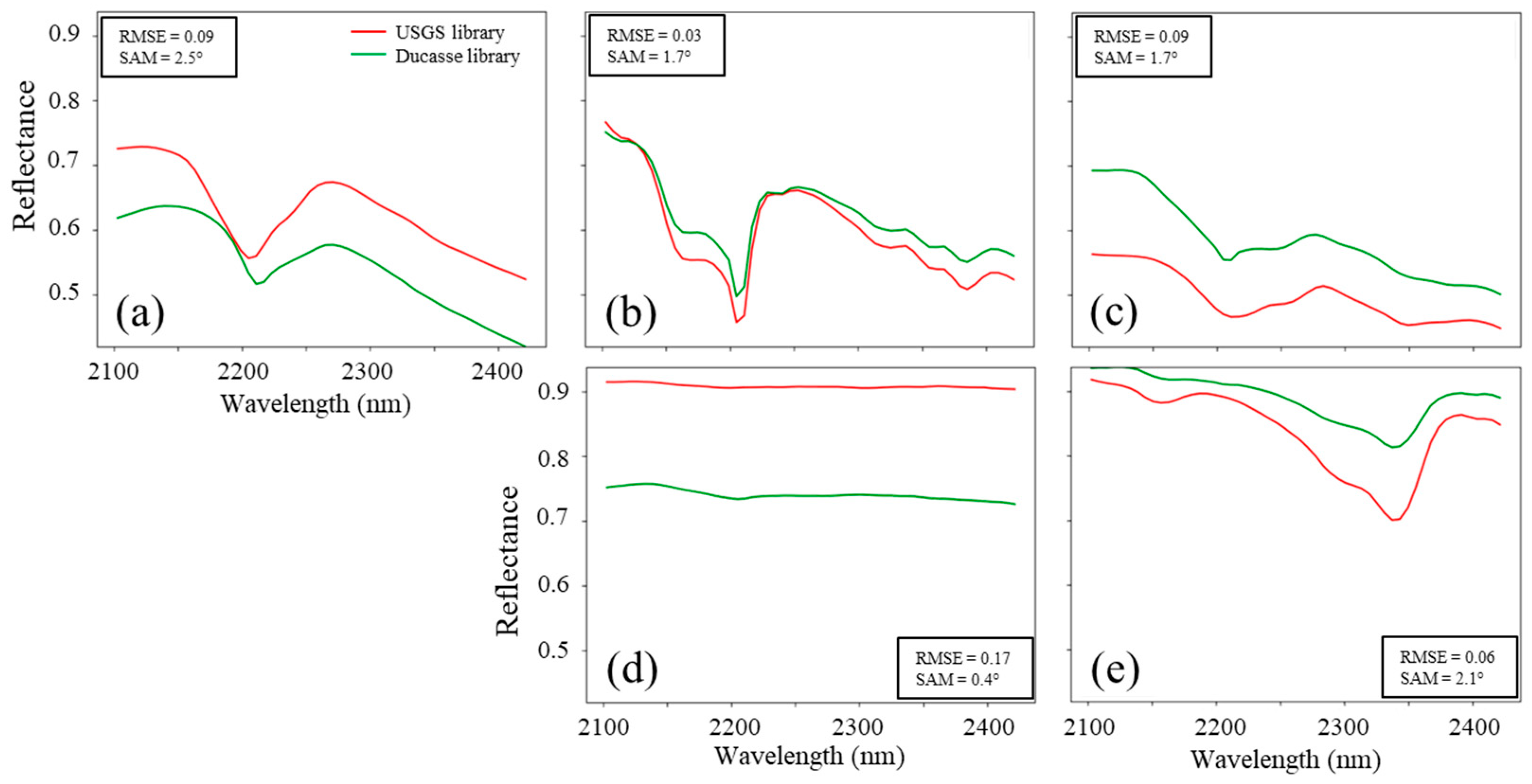
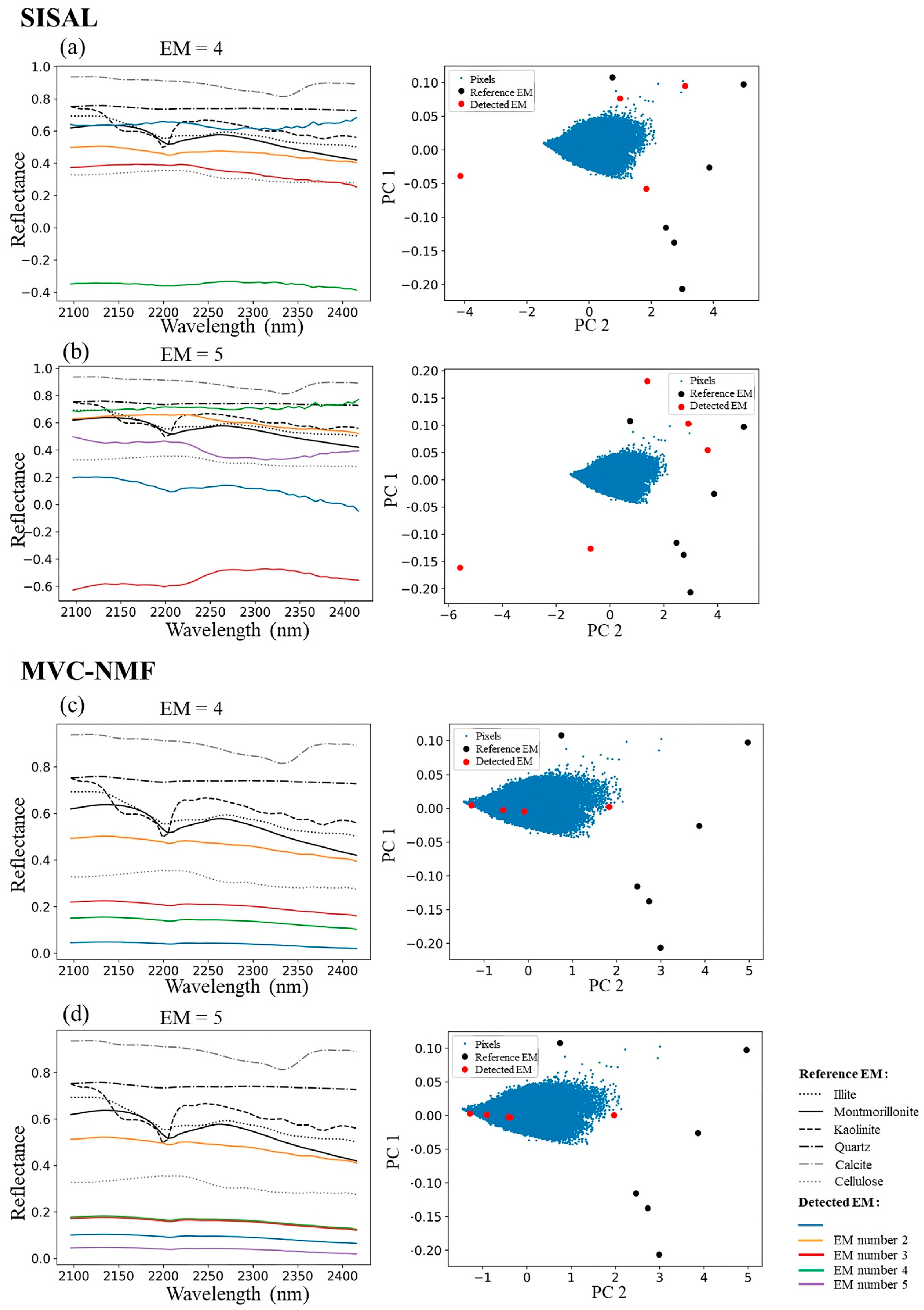

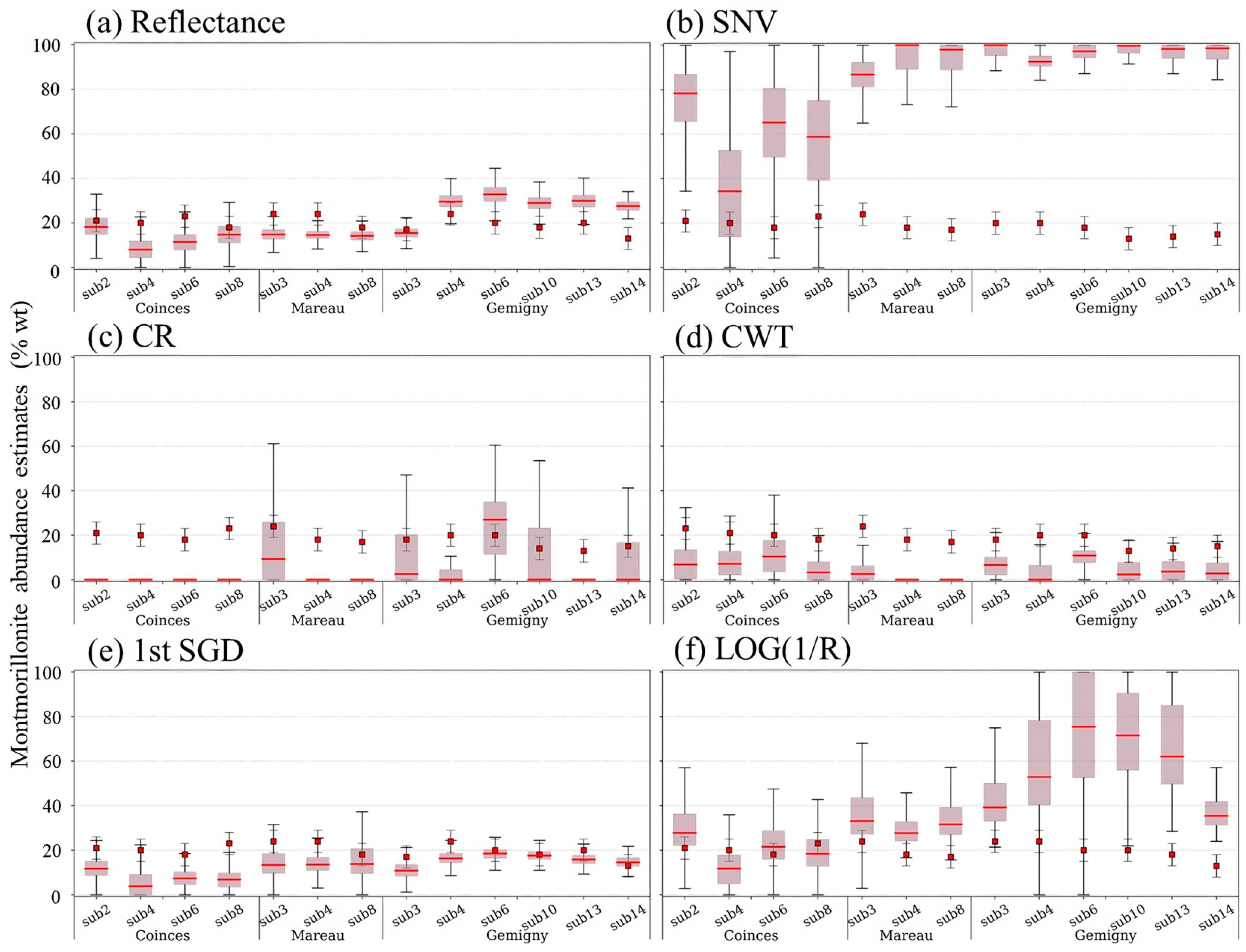
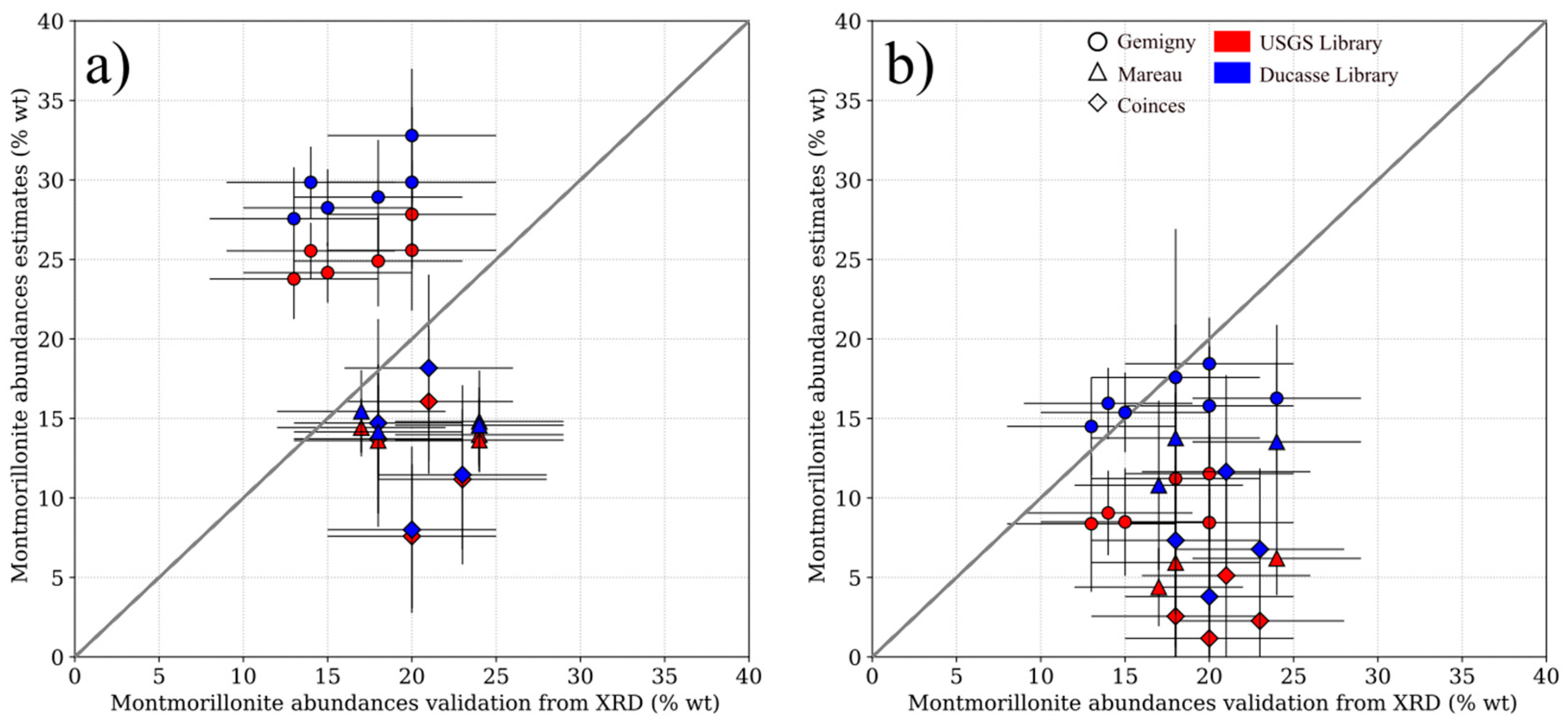

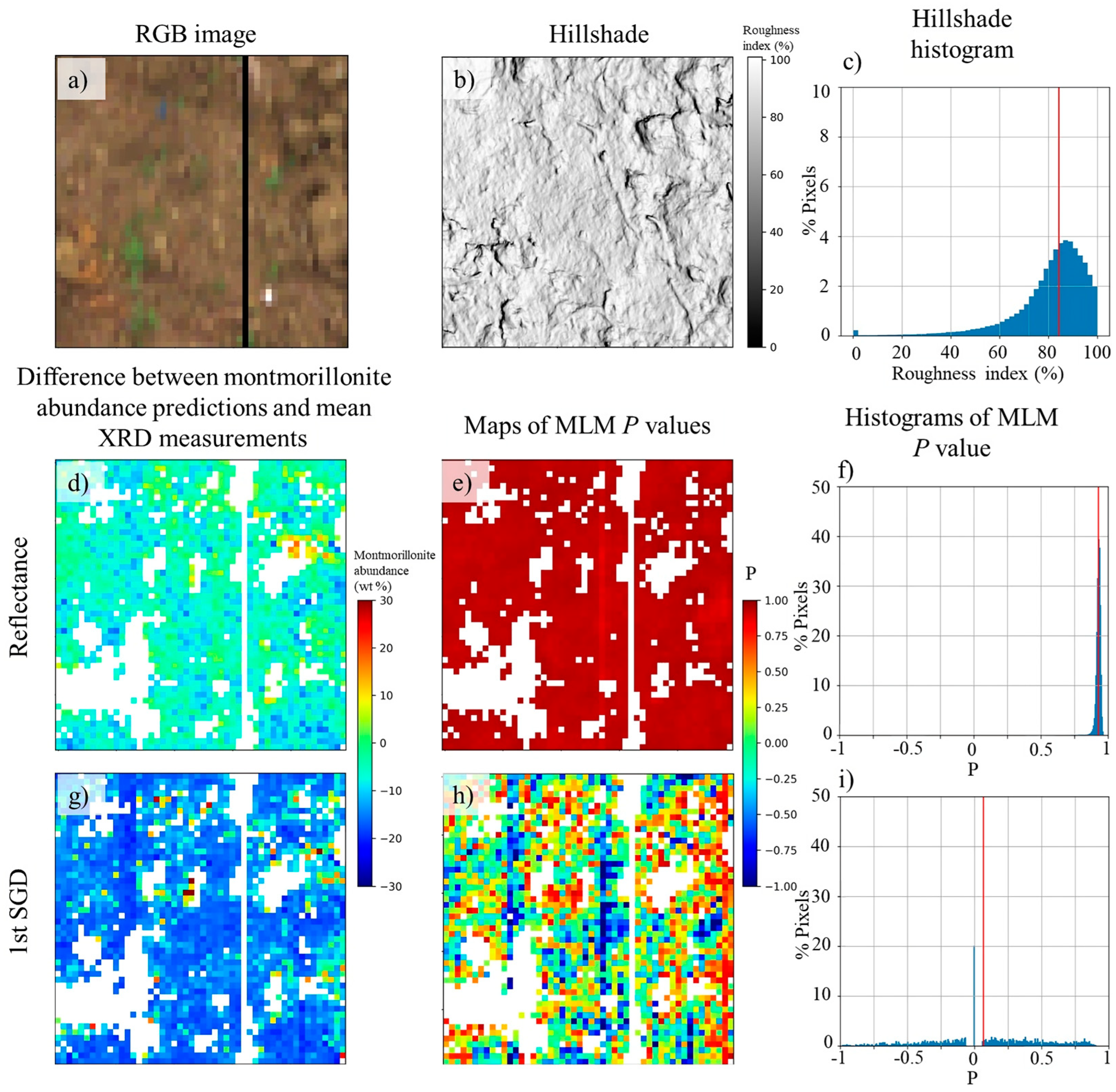
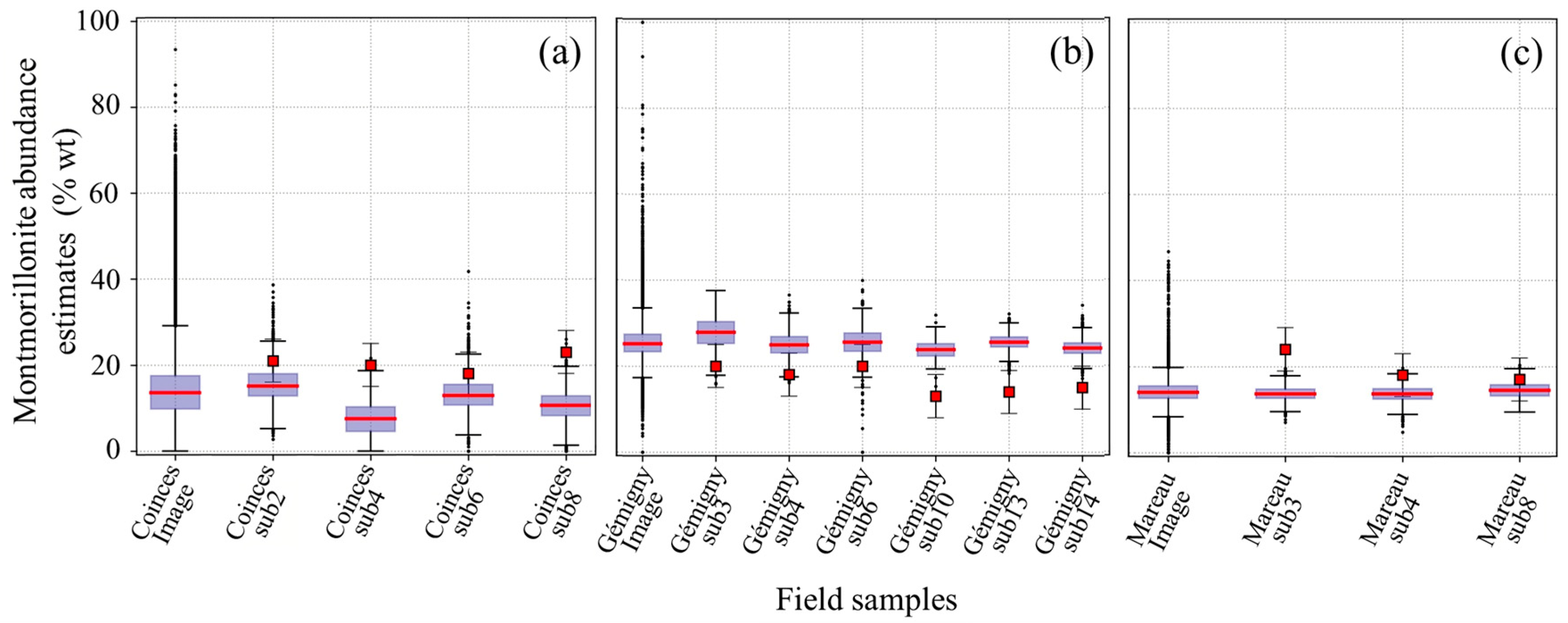

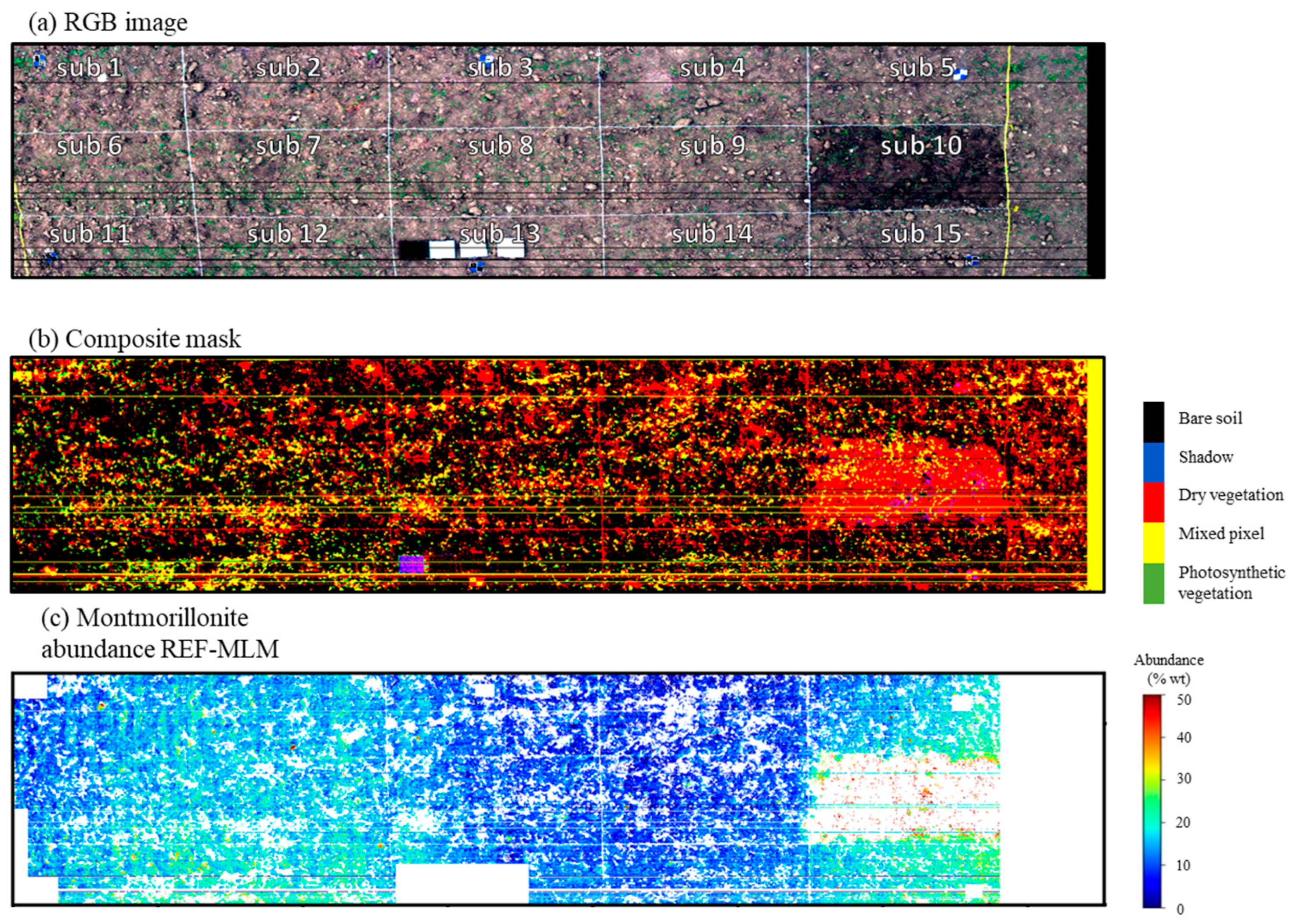


| Title 1 | Gémigny | Coinces | Mareau | |||
|---|---|---|---|---|---|---|
| Type of Mineral | Min | Max | Min | Max | Min | Max |
| Quartz | 58 | 68 | 58 | 64 | 29 | 31 |
| Smectite | 13 | 20 | 18 | 23 | 17 | 20 |
| Illite and/or micas | 3 | 5 | 1 | 4 | 6 | 10 |
| Kaolinite | 1 | 5 | 2 | 3 | 5 | 7 |
| Calcite | traces | traces | traces | 7 | traces | traces |
| Potassium Feldspars (Sanidine/Orthoclase) | 9 | 10 | 5 | 7 | 12 | 16 |
| Plagioclase Feldspars (Albite) | 4 | 7 | 5 | 6 | 18 | 24 |
| Quartz | 58 | 68 | 58 | 64 | 29 | 31 |
| REF-MLM | 1stSGD-MLM | |||||||||||
|---|---|---|---|---|---|---|---|---|---|---|---|---|
| Sample | Average Abundance | XRD Validation | MB | STDB | RMSE | R | Average Abundance | XRD Validation | MB | STDB | RMSE | R |
| Coinces sub2 | 15.6 | 21 | −5.4 | 4.3 | 6.9 | 7.6 | 21 | −13.4 | 6.6 | 14.9 | ||
| Coinces sub4 | 7.4 | 20 | −12.6 | 4.1 | 13.3 | 3.5 | 20 | −16.5 | 5.1 | 17.3 | ||
| Coinces sub6 | 13.2 | 18 | −4.8 | 4.3 | 6.4 | 3.7 | 18 | −14.3 | 3.3 | 14.7 | ||
| Coinces sub8 | 10.5 | 23 | −12.5 | 4.0 | 13.1 | 3.6 | 23 | −19.4 | 3.5 | 19.7 | ||
| Coinces all subs | 12.8 | 21 | −7.8 | 6 | 9.8 | −0.08 | 4.3 | 21 | −16.3 | 5.4 | 17.1 | 0.05 |
| Gémigny sub3 | 27.8 | 20 | 7.8 | 3.4 | 8.5 | 12.2 | 20 | −7.8 | 4.3 | 9.0 | ||
| Gémigny sub4 | 25.0 | 18 | 7.0 | 2.9 | 7.5 | 12.3 | 18 | −5.7 | 5.4 | 7.9 | ||
| Gémigny sub6 | 25.5 | 20 | 5.5 | 3.8 | 6.6 | 9.5 | 20 | −10.5 | 5.5 | 11.8 | ||
| Gémigny sub10 | 23.9 | 13 | 10.9 | 2.5 | 11.1 | 9.3 | 13 | −3.7 | 4.3 | 5.7 | ||
| Gémigny sub13 | 25.5 | 14 | 11.5 | 1.8 | 11.7 | 9.5 | −14 | −4.5 | 2.7 | 5.3 | ||
| Gémigny sub14 | 24.2 | 15 | 9.2 | 1.9 | 9.4 | 9.2 | 15 | −5.8 | 3.4 | 6.7 | ||
| Gémigny all subs | 25.6 | 17 | 8.6 | 3.4 | 9.2 | 0.27 | 10.7 | 17 | −6.4 | 4.6 | 7.9 | 0.23 |
| Mareau sub3 | 13.7 | 24 | −10.3 | 1.6 | 10.4 | 6.6 | 24 | −17.4 | 2.3 | 17.6 | ||
| Mareau sub4 | 13.6 | 18 | −4.4 | 2.0 | 4.9 | 8.4 | 18 | −9.6 | 8.4 | 12.7 | ||
| Mareau sub8 | 14.5 | 17 | −2.5 | 1.8 | 3.1 | 4.7 | 17 | −12.3 | 2.5 | 12.5 | ||
| Mareau all subs | 14.0 | 20 | −6.2 | 4.1 | 7.4 | −0.17 | 6.0 | 20 | −14.1 | 4.9 | 15.0 | 0.14 |
| All subzones, all sites. | 18.9 | 18 | 0.0 | 9.0 | 9.0 | −0.44 | 18.9 | −11.3 | −11.3 | 6.7 | 13 | −0.17 |
| REF-MLM | 1stSGD-MLM | |||||||||||
|---|---|---|---|---|---|---|---|---|---|---|---|---|
| Sample | Average Abundance | XRD Validation | MB | STDB | RMSE | R | Average Abundance | XRD Validation | MB | STDB | RMSE | R |
| Coinces sub2 | 17.6 | 21 | −3.4 | 5.9 | 6.8 | 12.3 | 21 | −8.7 | 5.5 | 10.3 | ||
| Coinces sub4 | 6.9 | 20 | −13.1 | 4.7 | 14.0 | 6.2 | 20 | −13.8 | 6.5 | 15.3 | ||
| Coinces sub6 | 13.6 | 18 | −4.4 | 6.3 | 7.6 | 7.9 | 18 | −10.1 | 4.3 | 11.0 | ||
| Coinces sub8 | 10.2 | 23 | −12.8 | 5.3 | 13.8 | 7.4 | 23 | −15.6 | 4.6 | 16.3 | ||
| Coinces all subs | 13.9 | 21 | −6.6 | 7.4 | 9.9 | −0.07 | 8.6 | 21 | −12.0 | 6.4 | 13.6 | 0.05 |
| Gémigny sub3 | 32.7 | 20 | 12.7 | 4.2 | 13.4 | 18.4 | 20 | −1.6 | 2.9 | 3.3 | ||
| Gémigny sub4 | 28.9 | 18 | 10.9 | 3.6 | 11.5 | 17.9 | 18 | −0.1 | 3.3 | 3.3 | ||
| Gémigny sub6 | 29.5 | 20 | 9.5 | 4.7 | 10.7 | 16.1 | 20 | −3.9 | 3.7 | 5.4 | ||
| Gémigny sub10 | 27.7 | 13 | 14.7 | 3.2 | 15.0 | 15.0 | 13 | 2.0 | 3.1 | 3.7 | ||
| Gémigny sub13 | 29.8 | 14 | 15.8 | 2.2 | 16.0 | 16.1 | 14 | 2.1 | 2.2 | 3.0 | ||
| Gémigny sub14 | 28.3 | 15 | 13.3 | 2.4 | 13.5 | 15.5 | 15 | 0.5 | 2.5 | 2.6 | ||
| Gémigny all subs | 29.9 | 17 | 12.8 | 4.00 | 13.4 | 0.26 | 16.9 | 17.1 | −0.2 | 3.4 | 3.4 | 0.29 |
| Mareau sub3 | 14.6 | 24 | −9.4 | 2.4 | 9.7 | 14.3 | 24 | −9.7 | 5.0 | 10.9 | ||
| Mareau sub4 | 14.1 | 18 | −3.9 | 2.9 | 4.9 | 17.3 | 18 | −0.7 | 13.2 | 13.2 | ||
| Mareau sub8 | 15.5 | 17 | −1.5 | 2.6 | 3.0 | 11.5 | 17 | −5.5 | 5.3 | 7.6 | ||
| Mareau all subs | 14.9 | 20 | −5.3 | 4.5 | 6.9 | −0.11 | 14.9 | 20 | −6.7 | 7.3 | 10.1 | 0.12 |
| All subzones, all sites. | 21.4 | 19 | 2.5 | 10.8 | 11.1 | −0.43 | 13.6 | 19 | −5.3 | 7.6 | 9.3 | −0.17 |
Disclaimer/Publisher’s Note: The statements, opinions and data contained in all publications are solely those of the individual author(s) and contributor(s) and not of MDPI and/or the editor(s). MDPI and/or the editor(s) disclaim responsibility for any injury to people or property resulting from any ideas, methods, instructions or products referred to in the content. |
© 2024 by the authors. Licensee MDPI, Basel, Switzerland. This article is an open access article distributed under the terms and conditions of the Creative Commons Attribution (CC BY) license (https://creativecommons.org/licenses/by/4.0/).
Share and Cite
Ducasse, E.; Adeline, K.; Hohmann, A.; Achard, V.; Bourguignon, A.; Grandjean, G.; Briottet, X. Mapping of Clay Montmorillonite Abundance in Agricultural Fields Using Unmixing Methods at Centimeter Scale Hyperspectral Images. Remote Sens. 2024, 16, 3211. https://doi.org/10.3390/rs16173211
Ducasse E, Adeline K, Hohmann A, Achard V, Bourguignon A, Grandjean G, Briottet X. Mapping of Clay Montmorillonite Abundance in Agricultural Fields Using Unmixing Methods at Centimeter Scale Hyperspectral Images. Remote Sensing. 2024; 16(17):3211. https://doi.org/10.3390/rs16173211
Chicago/Turabian StyleDucasse, Etienne, Karine Adeline, Audrey Hohmann, Véronique Achard, Anne Bourguignon, Gilles Grandjean, and Xavier Briottet. 2024. "Mapping of Clay Montmorillonite Abundance in Agricultural Fields Using Unmixing Methods at Centimeter Scale Hyperspectral Images" Remote Sensing 16, no. 17: 3211. https://doi.org/10.3390/rs16173211
APA StyleDucasse, E., Adeline, K., Hohmann, A., Achard, V., Bourguignon, A., Grandjean, G., & Briottet, X. (2024). Mapping of Clay Montmorillonite Abundance in Agricultural Fields Using Unmixing Methods at Centimeter Scale Hyperspectral Images. Remote Sensing, 16(17), 3211. https://doi.org/10.3390/rs16173211










